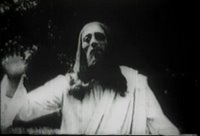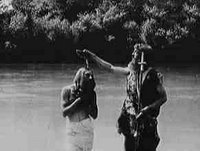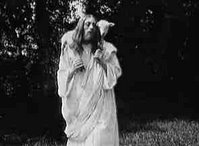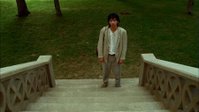 The Silents of Jesus in the Cinema (1897-1927)
Edited by David J. Shepherd
The Silents of Jesus in the Cinema (1897-1927)
Edited by David J. Shepherd
Routledge, Taylor and Francis (2016)
292 pages
61 B/W Illustrations.
Hardback
ISBN 978-415741699
Whilst regular readers will know that I have mentioned and quoted from this book extensively over the last year or so gave my own opinions on the films it covers in my Silent Jesus Films series, I thought a proper review was somewhat overdue.
Having established himself as the leading expert on Silent Bible films with his 2013 work "The Bible on Silent Film" David J. Shepherd has edited a book with a more specific focus on the major films about Jesus from the first thirty years of the cinema. The book covers thirteen silent Jesus films in depth, giving a chapter to each apart from the two 1920s German films,
Der Galiläer and
I.N.R.I. (1923) which Reinhold Zwick covers in a single chapter. Shepherd himself provides a chapter on Alice Guy's
La naissance, la vie et la mort du Christ (1906) as well as an introduction and "Final Reflections". The Introduction (pp.1-14) starts with the "ironic" observation of "how early and how frequently Jesus appeared in the cinema of the so-called 'Silent Era'" (p.2) given his reputation as a teacher and the sheer number of his sayings that have been passed down. It continues with a brief historical overview of the portrayal of Jesus across the silent era.
Before the films themselves, however, there is Timothy Barnard's translation of one of André Gaudreault's contributions to the difficult to obtain "Une Invention du Diable?" (1990), which in this volume's English translation is titled "The Passion of Christ: A Form, a Genre, a Discourse" (p.15-23). Gaudreault considering the very earliest passion play films asks if they are "documentary or fiction?" (p.19) ultimately concluding that they are "neither one nor the other...(but)...overlap considerably" (p.22). The volume from which this paper is taken was a comprehensive collection of the papers from the first international conference of DOMITOR (the
International Association to Promote the Study of Early Cinema), the majority of which are in French. Whilst a god deal of it is available on
Google Books, the inclusion of an English translation here is much appreciated. It's apt too given many of the papers in the present work originated at an SBL meeting in Amsterdam and an international symposium in Vienna (p.xi).
The first film to be covered in detail then is
La Vie et Passion de Notre Seigneur Jésus-Christ (1902–05) .The 1902-1905 dating is that given by the chapter's authors Alain Boillat and Valentine Robert and it proceeds to present evidence that the popular
DVD version which is usually dated as being 1902-1905 was in fact a new version created in 1907. The version examined in this chapter (p.24-59) then was the second of four passion plays by Pathé (p.27), although both version were directed by Ferdinand Zecca (p.36). Boillat and Robert also examine the earlier film's reliance on Gustave Doré's compositions.
In between the two Pathé/Zecca films however was the release of Alice Guy Blach
é's
La naissance, la vie et la mort du Christ (1906) which is covered by Shepherd himself in chapter 3 (p.60-77). Shepherd's main observations here are around the influence of Jacques Tissot's work and, in particular, the film's emphasis on women ("The Gospel According to Alice Guy" as the chapter title has it). This is often done by contrasting the alterations Guy makes to Tissot's compositions or the equivalent scenes in Zecca's films.
The comparison with Zecca's films is also taken up in the fourth chapter, "
La Vie et Passion de Notre Seigneur Jésus-Christ (Path
é Frères 1907): The Preservation and Transformation of Zecca's Passion" by Dwight H. Friesen (p.78-97). Friesen argues that the two filmmakers had "noticeably different" (p.88) approaches. Compared to Guy, Zecca was "less natural and more constructed" (p.88) not least because of Guy's use of outdoor locations (p.89). Zecca's later film seems "to contest and react" to Guy's film and even "appropriate" from it on occasion (p.89).
W. Barnes Tatum's chapter on
From the Manger to the Cross(1912) (p.98-110) begins with an assertion that in terms of films about Jesus, "(n)o film from the early silent period was more important" (p.98). Given the success of his book "Jesus at the Movies"
1 it's hardly surprising that much of the material here is reworked. There is however expanded material on the making of the film and the cast and crew's trip to Cairo and Jerusalem from New York (and in Henderson Bland's case, London) (p.99).
The next two chapters, Terry Lindvall's "
The Star of Bethlehem (Thanhouser, 1912): The Sacred Story from King Herod to the Crib" (p.111-131) and Rhonda Burnette-Bletsch "
The Shadow of Nazareth: The Hermeneutics of an Unauthorized Adaptation" (p.132-157) cover two of the lesser known films of the era (though I have reviewed them
here and
here). Noting that the
The Star of Bethlehem "did not receive a uniformly stellar reception" (p.126) Lindvall examines how the film attempted to use special effects and star power
2 to bolster its appeal; how the film faced criticism, not least from the "self-proclaimed guardian of the textual and aesthetic orthodoxy of sacred film", W. Stephen Bush; and how director Lawrence Marston defended his film by citing his research and use of experts.
Burnette-Bletsch tackles
The Shadow of Nazareth from a different angle, particularly how the film "not only harmonizes but also substantially rewrites the gospel accounts" (p.133). The film, Burnette-Bletsch argues is a "mediated adaptation" of the gospel narratives" because the evidence suggests it is an "unacknowledged cinematic adaptation" of the 1893 novel "Barabbas: A Dream of the World's Tragedy" by Marie Correlli (p.134). The book had been a "spectacular commercial success" (p.140), indeed Corelli was "the best-selling novelist of her generation" (p.139). The novel drew "upon popular conceptions of Darwinism and Buddhism" as part of a "discussion of the spiritual issues" of the day such her belief in "unlimited opportunity to evolve spiritually" and ultimately "experience spiritual transcendence" (p.143). In contrast, "the film is not concerned with the possibility of redemption, spiritual evolution or transcendence" it "simply uses Jesus and Christian iconography as a culturally shared symbols of a moral universe in which...all of the sinful characters in the film receive the due penalty for their errors" (p.152).
Pathé's fourth foray into the Passion play tradition is the subject of Jo-Ann Brant's "
La Vie et Passion de Notre Seigneur Jésus-Christ (Pathé-Frères, 1913/14): Pathé’s Inclination to Tell and Maître’s Instinct to Show" (p.158-178). The film not only used the same title as the 1902-05 and 1907 versions, but also maintained a "continuity of appearance" (p.160) with the earlier film. Yet Brant argues that despite the similarities to the 1907 film Maître’s "departures from that film indicate that he has sought to add interest and narrativity...by exploiting deep staging to codify space and by directing our attention away from Jesus to the
mise en scène" (p.170). Brant also speculates as to the reasons "why Pathé gave an old look to a new film" (p.161) suggesting that, in part their version had become in some way "authoritative" such that were they "to have departed too radically from the visual canon it had helped to create, it would only have undermined its own hold on the market" (p.162).
That "old look", however, dated even more quickly than might have been anticipated, with the release of D.W. Griffith's films
Judith of Bethulia (1914),
Birth of a Nation (1915) and
Intolerance (1916), the subjects of Richard Walsh's chapter subtitled "Griffith's Talismanic Jesus" (p. 179-199). Looking primarily at the latter two films as well as Ince, Barker and West's
Civilization (1916) he notes how Griffith simply uses Jesus as "a means to hallow some characters, (and) to demonize others" (p.192). "Jesus bathes the truly important characters in Griffith's film and film itself in his cultural sanctity." (p.193)
The same year that Griffith's
Intolerance was being unleashed on the the world, Giulio Antamoro's
Christus finally "received initial approval from the censors" (p.201). Giuseppe Pucci's "
Christus (1916): Italy's First Religious 'Kolossal' by Antamoro and Salvatori" (p.200-210) covers the film's characters and reception and looks at how the film is divided into three 'mysteries', namely those of Jesus' birth, preaching and passion (p.201).
Of all the films considered in this book perhaps the ones that have ultimately been the most important are Dimitri Buchowetzki's
Der Galiläer (1921) and Robert Wiene's
I.N.R.I. (1923). Jesus films shape their audience's perceptions such that whilst it would be foolish to suggest that these anti-Semitic Jesus films led to the Holocaust, they doubtless contributed to the cultural demonisation of the Jewish people. As noted above Reinhold Zwick's contribution to the book covers both these films. "
Der Galiläer (Express-Film, 1921) and
I.N.R.I (Neumann-Film, 1923): The Silence of Jesus in the German Cinema" (p.211-235) covers far more issues than just the anti-Semitism, but nevertheless in several places it refers to issues such as
Der Galiläer's "anti-Semitic stereotypes" (p.217) and the bitter "irony that the anti-Jewishness was evidently seen as fully compatible with the aim of restoring the moral reputation of Germany" (p.224). Zwick charts the two films' journeys from stage/page to screen and the "Image of Jesus Christ" that they create. The latter sections break down into "A Man of Few Words", "A Man of (Miraculous) Deeds" before examining how others in the film see Jesus. Zwick includes two "Scene Lists" in his appendices, the second, for
I.N.R.I. compares the differing fragments from archives in Berlin and Gemona.
Whilst Buchowetzki was working in Germany Carl Theodor Dreyer was directing
Blade Af Satans Bog (Leaves from Satan's Book, 1921). "Dreyer had been so impressed by D.W. Griffith's
Intolerance (1916)...that it served as a source of inspiration" (p.237) to the extent that it copied its four-differing-stories structure, though it did not intertwine them in the same complicated fashion. "Dreyer was not happy with the first episode of
Leaves" calling his portrayal of Jesus "'a bad tailor's dummy of Christ'" (p.243) and deciding to pursue another film about Jesus. Caroline Vander Stichele uses her chapter "
Leaves from Satan's Book, Nordisk, 1921) and Dreyer's Script
Jesus of Nazareth (1950): The Jewishness of Jesus" (p.236-255) to both examine the original film, but also to compare it to the script that resulted from his dissatisfaction. The script has survived but as Stichele points out "we are left to imagine how he might have directed it. In a sense both are 'silent' for in neither film nor script can we 'hear' the characters."(p.236) Whilst it's an interesting concept Stichele devotes more attention to the latter film even though it is appears, to me at least, somewhat outside the rest of the book's thrust.
The final film to be covered is DeMille's famous
The King of Kings (1927) which is tackled by Vivienne Westbrook (p.256-270). Westbrook's focus is particularly on the film's intertitles and his "editing, abbreviating, elaborating, re-ordering and even combining biblical texts (rather than simply quoting them ) to suit his purposes" (p.269). It's a detailed and careful study that does much to highlight how much silent film evolved in its thirty-year run from primitive title cards announcing the scene in the earliest films, to succinct explanations or lines of dialogue, replete with biblical quotations and background images by DeMille's day.
Shepherd's "Final Reflections" (p. 271-280) not only provides a neat summary of the chapters that have gone before, but also continues on to Duvivier's
Golgotha (1935), the first major film of the sound era. Shepherd makes the point that whilst Duvivier finally had "the capacity to allow audiences...to actually hear for the first time...the words of Jesus", he "chose instead to focus his film on the Passion, in which Jesus has far less to say" (p.276). Golgotha "invites viewers to marvel more at the spectacle of Jesus's silence than his newly audible words" (p.278) just as silent era Jesus films had prioritised spectacle over almost anything else.
Shepherd's reflections also do a great deal to gather the book's various straws together. One of the undoubted strengths of the volume is the way it brings to light lesser known productions and using them to fill gaps in the previously patchy narrative of the earliest era of the Bible on Film. Inevitably this means that the better known films are covered in a somewhat different manner to some of the more obscure titles, which the authors had to introduce and describe as well as analyse. However, whilst some diversity is clearly essential sometimes it feels like the inconsistency between chapters is too diverse. It's a minor point that will probably only bother those reading the book in a relatively short space of time. Also, the chapter order is occasionally a little odd e.g. Pucci's chapter on
Christus would have been better before
Intolerance, but that really is a minor nitpick which just goes to demonstrate how well I think of the book as a whole.
Otherwise, "The Silents of Jesus", is an excellent and most welcome addition to the growing library of books on the gospels on film. Often with multi-authored books such as this one or two essays don't quite meet the mark, but here they are all well worth reading. In addition to the text the wealth of images that are included make many vital points far more clearly than would have been possible without them. Furthermore not only is it packed full of insight and good scholarship, it's an enjoyable book to read, one which shines a light onto a world which we're only just re-discovering.
======
1 - Tatum's book is the only book on the subject to gain a third edition, as far as I am aware.
2 - Yes, I went there. But Lindvall started it.Labels: Books, Silent Bible Films, Silent Jesus Films






































